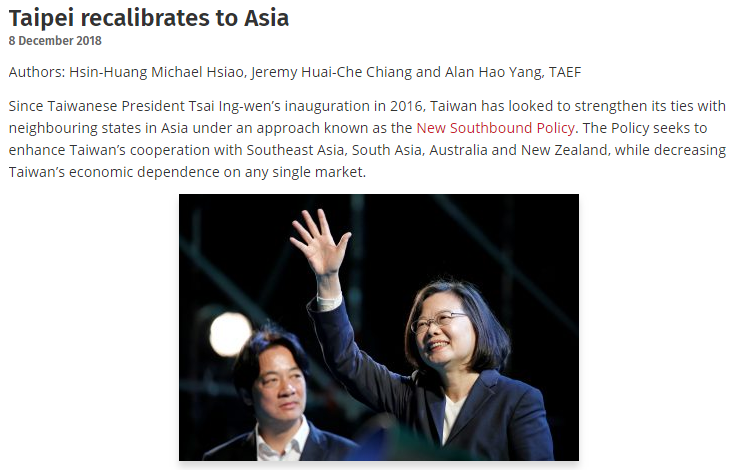Since Taiwanese President Tsai Ing-wen’s inauguration in 2016, Taiwan has looked to strengthen its ties with neighbouring states in Asia under an approach known as the New Southbound Policy. The Policy seeks to enhance Taiwan’s cooperation with Southeast Asia, South Asia, Australia and New Zealand, while decreasing Taiwan’s economic dependence on any single market.
Taiwan has long promoted the regionalisation and internationalisation of its existence. In previous decades, Taiwan has relied heavily on the United States’ security assurance to play the Taipei–Beijing–Washington ‘strategic triangle’. But with the world heading towards a multipolar future, the Tsai Ing-wen administration is adapting Taiwan’s foreign policy approach and broadening its overseas relationships.
The new policy has had some initial successes. Taiwan’s high levels of trade and investment with China are yet to drop. But bilateral trade with Southeast and South Asian countries grew around 15 per cent from 2016–17, while Taiwan’s investment in these countries rose by 54 per cent.
While China is on track to be the world’s largest economy in 2050, India and Indonesia will rank second and fourth respectively. Southeast and South Asia are rising players in world politics. And while China’s assertive influence in the region is inducing some, it is also irritating many others and creating new opportunities for Taiwan.
One example is India. The largest democracy in South Asia has stopped mentioning ‘One China’ in its joint statements with China in recent years. It also warmly welcomed Taiwan’s parliamentary delegation to India in early 2017 despite protests by the Chinese Foreign Ministry. Taiwan is now helping to incubate India’s technological talents with its world-renowned semiconductor and engineering industry, and the Indian government has recently approved a bilateral investment agreement between India and Taiwan.
Australia, on the other hand, demonstrates the challenges of Taiwan’s new diplomatic initiative. The country seems to be stuck in an internal debate. Despite being deeply concerned with China’s interference in domestic academic freedom and politics, Australia has abandoned plans for a free trade agreement with Taiwan after warnings from Beijing, while the Australian state of Victoria formally signed up to China’s Belt and Road Initiative in October 2018.
The Australian case speaks to the core dilemma of Taiwan’s New Southbound Policy. While countries in the region express their willingness to cooperate with Taiwan, and while Taiwan has no intention to force countries to take sides between Taipei and Beijing, the ‘China factor’ hinders them from furthering their ties with the island in any meaningful way.
In response, Taipei is focusing on ‘softer’, more ‘people-centred’ and less politically sensitive areas of cooperation such as talent training, public health, agriculture, technology, culture and arts, trade and non-traditional security.
The New Southbound Policy’s five flagship programs — innovative industries, medical cooperation and industrial supply chains, policy forums and youth exchange, regional agriculture, and talent cultivation — are representative of Taiwan’s strengths. And they are areas where practical cooperation with regional countries is possible.
Taiwan has already secured 17 public projects in targeted nations with a combined bidding price of US$25.2 billion, and won 20 projects with a total bidding price of US$25 billion in 2018. Taiwan’s quality development experience does have an edge over the ‘China model’, especially in ‘soft infrastructure’ areas.
Taiwan’s appeal, with its technologically innovative industries and governance experience, is reflected in the increasing number of visitors to Taiwan. In the first half of 2018 alone, Taiwan welcomed more than 41,000 students from neighbouring countries, compared to 20,207 in the 2012– 13 school year. And more than 4 million tourists from Southeast and South Asia have visited Taiwan since 2016, helping Taiwan to facilitate its ‘people-centred’ regional initiatives.
The New Southbound Policy is a step in the right direction to prepare Taiwan for the future. It presents a shared vision for socio-economic development in Asia that is in the interest of all parties. But the Policy still needs to deal with certain challenges.
As Taiwan is a relatively resource-limited country compared to other major powers in Asia, the New Southbound Policy will have to sharpen the strategic deployment of its resources to see substantial results in key fields and countries.
Taiwan should also keep in mind the lessons of the ‘Go South’ policies of previous administrations. While the government and state-owned enterprises should take the lead, more voluntary participation from the private sector and civil society needs to be encouraged.
As the ‘China factor’ still looms large, Taiwan will also need innovative strategies to enable cooperation opportunities in the region. This includes formulating concrete proposals that work in tandem with the development agendas and strategies of partner countries.
Though there are challenges ahead for the New Southbound Policy, Taiwan is not alone in its endeavours. Its regional strategy is not an effort in isolation, but a timely response to a common challenge. Regional countries who likewise cherish peace and stability in the Asia Pacific should work with Taiwan to help it achieve its foreign policy ambitions and build a more interconnected future.
HH Michael Hsiao is Chairman of Taiwan-Asia Exchange Foundation, a policy-oriented think tank in Taiwan founded in 2018 with a focus on Southeast Asian and South Asian affairs. He served as national policy advisor to the president of Taiwan between 1996 and 2006, and is currently Senior Advisor to the President of Taiwan.
Jeremy Huai-Che Chiang is Research Assistant in the Taiwan-Asia Exchange Foundation.
Alan Hao Yang is Executive Director of Taiwan-Asia Exchange Foundation. He is also Deputy Director of the Institute of International Relations and Executive Director of the Center for Southeast Asian Studies at National Chengchi University, Taiwan.
This article was published on East Asia Forum.
